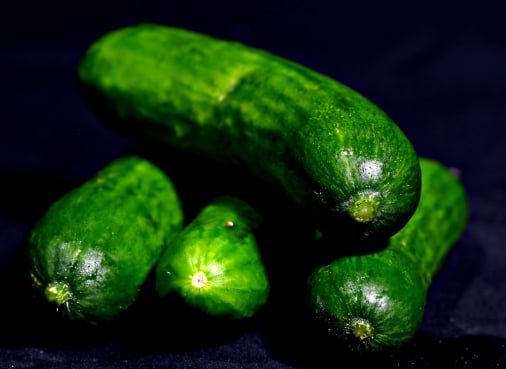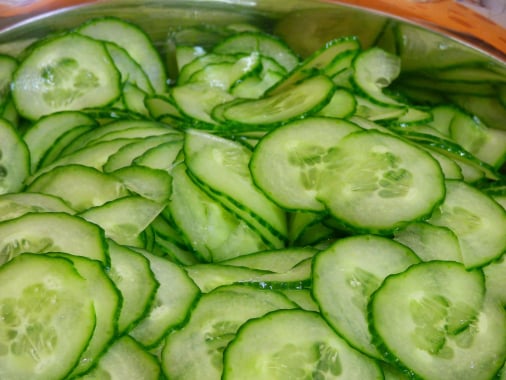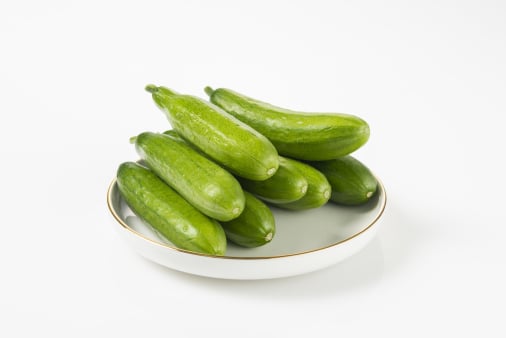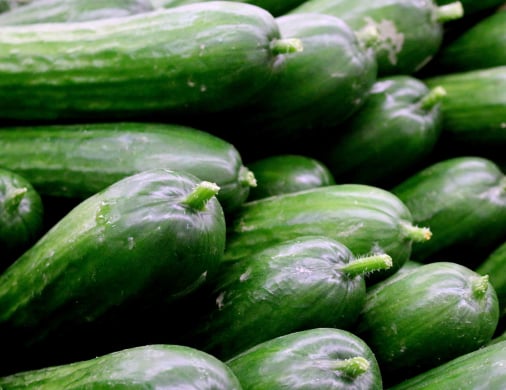Cucumber traceability app for processing, washing, sorting, grading, and packing cucumbers. Cucumber traceability up and down the supply chain. Full quality, recall, inventory, invoice / order / sales, and shipping management. Cucumber traceability made easy for cucumber packers, wholesale, and value adding.
Cucumber traceability app for processing, washing, sorting, grading, and packing cucumbers. Cucumber traceability up and down the supply chain. Full quality, recall, inventory, invoice / order / sales, and shipping management. Cucumber traceability made easy for cucumber packers, wholesale, and value adding.

Cucumber Traceability during production & packing
View Traceability App Specifications.
Traceability for Cucumber, Fresh & Processed Fruits, Vegetables and Cut Flowers
Filed Under: Certification | Tagged: 2020 Certification Program, Supply Chain Certification, Traceability, Bananas, Flowers
Marketplace 2.0, the Rainforest Alliance online traceability platform, now includes all fresh and processed fruits, vegetables and cut flowers, so it is even easier to trace Rainforest Alliance Certified products through supply chains, and to authorize trademark approvals.
Traceability matters
Our stakeholders – including consumers, brands, other NGOs, and consumer advocacy groups –regularly challenge us to demonstrate how we ensure our claims of Rainforest Alliance Certified content. Traceability helps us back up the claim that any products bearing the Rainforest Alliance seal come from Rainforest Alliance Certified sources. It means that consumers and companies can trace a product back to a Rainforest Alliance certified farm of group. This process helps us safeguard the integrity of the Rainforest Alliance seal.
Collecting this data centrally at the Rainforest Alliance, allows us to have visibility through the entire supply chain, from origin to final distribution, and thus can assure the integrity of the Rainforest Alliance seal.
Every stage of its journey documented, so consumers are certain of what they are buying. Companies can also benefit from traceability because it can make their supply chains more transparent, identify possible weak spots and work on further improvements. And farmers can track farm development, but also gain access to new markets.
In summary, traceability can:
support the credibility and consistency of use of the Rainforest Alliance Certified trademark, certified claims and the seal on-pack and off-pack
maintain the credibility of claims that and products have originated from Rainforest Alliance Certified farms and the integrity of the Rainforest Alliance seal
Cucumber traceability management
For the small-scale and scattered fresh cucumber production in China, the result that production record-keeping and its transfer are inefficient have prevented the wide application of traceability systems in China. With the mobility and computability, Personal Digital Assistant (PDA) provides a new way for agricultural information collection to solve the above problems. Thus a PDA-based Record-keeping and Decision-support System (PRDS) for traceability in cucumber production was developed on Windows Mobile platform invoking a Geographic Information System (GIS) control. For improving the decision making feasibility of PRDS, the fertilization recommendation model and pesticide usage early warning model were developed by using the Technical Specification of Balanced Fertilization by Soil Testing and the Guideline for Safety Application of Pesticides in China. The architecture of PRDS was provided. With Unified Modeling Language (UML), a requirement model including two types of users and 17 use cases was described, and a static class model was also designed, which consisted of table class, table operation class, algorithm class and interface class. Based on these models, the functions of system setup, map management, data management, production record-keeping and decision-support and query, etc., were implemented by adopting Hosting MapInfo MapX Mobile Controls on the .NET Compact Framework 2.0, and the data synchronization was realized by Remote Data Access

Cucumber packhouse hygiene checklist for food safety
Traceability can be a tool for safety and quality assurance for food perishables as well as for process optimization and economic gain. However, it is often considered mere bureaucracy and an economic burden. Such is prevalent in small and medium-sized enterprises. As they constitute most of food sector, the adoption of traceability systems is quite slow and mostly to satisfy legal requirements.
To determine the main advantages and disadvantages of traceability models, implementation and technologies, a literature review and Small and Medium Enterprises (SME) focused analysis was performed in the part Ⅰ of this study.
In Part Ⅱ, a low cost open-source traceability focused on food safety and quality is developed. It is based on HACCP flowcharts to define gateways for quality evaluation and encompasses external verification and product history maintenance.
Economic gains, more quality and safety, better efficiency and a more direct contact with consumers are some of the main advantages. High implementation costs, poorly defined benefits, lack of compatibility, consumer focused perspective and exposure of sensitive information are some of the main issues.
This study serves to expose these issues and suggest solutions, aiming to encourage the adoption of traceability systems, with last-end benefits to producers, retailers, and consumers.
CUCUMBER TRACEABILITY SYSTEM
There are several definitions and principles of traceability that result in its development taking different directions. As such, there is not a common understanding about the definition and structure for food traceability systems [1].
Food traceability can be defined as the ability to track a product batch and its history through the whole, or part, of a production chain from harvest through transport, storage, processing, distribution, and sales or internally in one of the steps in the chain. Traceability is a generic issue and independent of the type of product, production, and the control system it serves. Traceability is a quality control tool and should be implemented systemically, leading to the development of a traceability system that records information about a product and its movements [2].
Other definitions of traceability exist. ISO 8402 defines traceability as the ability to trace the history, application, or location of an entity by means of recorded identifications [3]. This standard was then superseded by the ISO 9000 that defines traceability as the ability to trace the history, application, or location of that which is under consideration [4]. The standard ISO 22005 is identical to the ISO 9000 but is specific to food supply chains [5]. All these standards have an additional clause that indicates that when relating to products, the information about the origin of materials and parts, the processing history, and the distribution and location of the product after delivery should be kept. The Codex Alimentarius defines traceability as the ability to follow the movement of a food through specified stage(s) of production, processing, and distribution [6]. The General Food Law, defines traceability the ability to trace and follow a food, feed, food-producing animal or substance intended to be, or expected to be incorporated into a food or feed, through all stages of production, processing and distribution [7].

Cucumber Traceability management best practices
Although international regulations exist for traceability, each country can implement additional regulations to increase the comprehensiveness and effectiveness of traceability. In Europe, regulations are already comprehensive and establish Europe as the leader and example to follow [8]. Thus, a robust traceability platform exists that can benefit from the automation of information exchange as a way to facilitate the enforcement of regulations, speed up sanctions and limit the dissemination of improper commodities, as, according to Lupien [9], the possibility of occurrence of alimentary quality and safety flaws still exists.
Traceability is used in several activities as information technology, statistical analysis, electronics, biology, logistics, supply chain management and food industry. Traceability systems have the potential to increase security, quality, reliability, and precision. These advantages have an impact in consumer protection and company productivity [10].
Traceability allows the consumers to trust consumed products and pay the correct price. It also prevents the occurrence of health issues, increases environmental sustainability and prevents the invasion of non-indigenous species [11].
According to Opara [12], the demand for traceability systems has been growing significantly in the last years due to faults in alimentary security and the emergence of genetically modified organisms. These situations contribute to the reduction of consumers' trust and increase the concern with the potentially negative consequences of existing practices. To prevent those consequences, new regulations were introduced and aim to hold responsible entities that neglect safety. To correctly determine responsibility, enterprises must demonstrate that all diligences were complied with. Consequently, rises the necessity of a system that can assure product quality and allows regulators and companies to know the time and space evolution of quality and safety of food products to better deal with eventual food crisis. Thus, a traceability system based on quality and safety functions as a preventive tool as it helps producers to effectively manage the quality, locate and isolate threats to food safety. The evolution of information and communication technologies (ICT) has increased the speed and precision of data collection and thus, can present reliable and transparent information to the consumers.
Traceability can be part of a system that provides information about all production stages. To achieve chain-wide traceability, it is necessary that all stakeholders can monitor and store information internally and be able of transmitting it externally to connect outputs (selling) and inputs (buying).
In addition to the existence of considerably different traceability systems and their lack of compatibility, traceability suffers from issues that need to be solved, as the exposure of sensitive information, emergence of copies, necessary investment, and loss of autonomy.
This review aims to clarify the main issues associated with traceability models and systems. Although some issues arise on a general level, the analysis and solutions proposed in this paper give special consideration to the implementation of these systems in Small and Medium Enterprises (SME), due to the general specificities of this kind of companies, such as the reduced number of collaborators, lack of expert technicians, the reduced available amount for research and development activities and for the acquisition of traceability systems, either hardware (data loggers, communication systems, network devices, among others) or software (alert systems, support decision-making applications, among others).

Cucumber Supplier Traceability Management
CUCUMBER TRACEABILITY
MIAMI, FL - Continental Fresh has announced a new and fully implemented, case-level labeling and traceability system. Also applying its Produce Traceability Initiative-compliant labels on each of its Atlas Fresh cucumber and winter squash cases, the company says this is something that has yet to be done by anyone else in the industry.
Continental Fresh's New Traceability Label
Continental Fresh's New Traceability Label
Amid recent outbreaks of salmonella on cucumbers from Mexico and the FDA’s new Food Safety Modernization Act, Continental Fresh has made it an priority to reconfirm its commitment to traceability for its products.
Albert Perez, President, Continental Fresh
Albert Perez, President, Continental Fresh
“We expect to be the only offshore cucumber importers in the country to have PTI case-level tagging originating at our farms in Honduras,” explained Albert Perez, President of Continental Fresh LLC. “We are also implementing this on all of our retail and process butternut and spaghetti squashes.”
Perez also noted that Honduran cucumbers in particular have come a long way in recent years in terms of quality and consistency.
“Customers have put great faith in our programs and each year more of the needs of the east coast are met by our products,” he said. “As a leader in the import of Honduran vegetables, we at Continental Fresh LLC hope that others follow our initiative in making it the premium choice in food safety.”
Atlas Fresh Cucumbers
Atlas Fresh Cucumbers
According to a press release, the import season for Honduran cucumbers runs from late December until mid-March, while Butternut and Spaghetti squashes are available from January through April.
For more information about Continental Fresh and its traceability programs, visit www.continentalfresh.com.